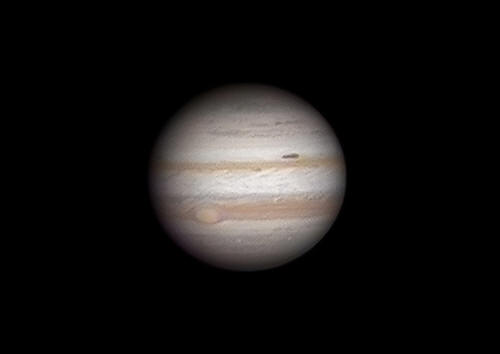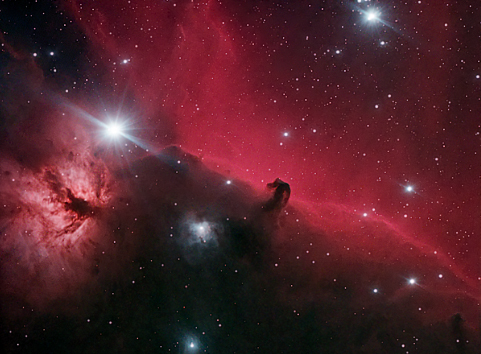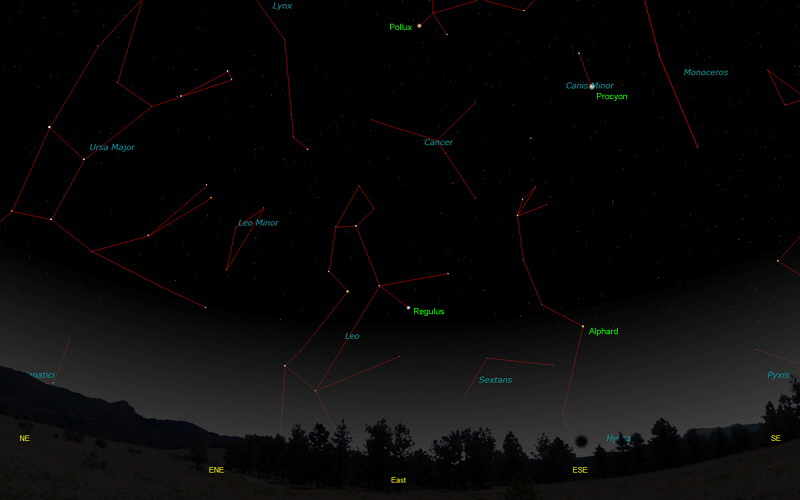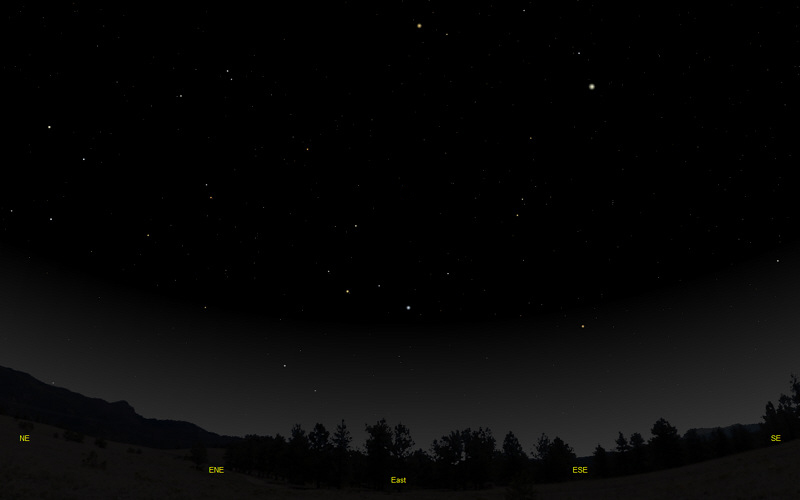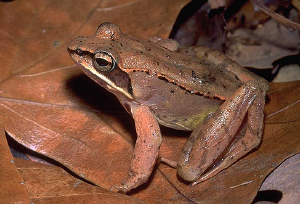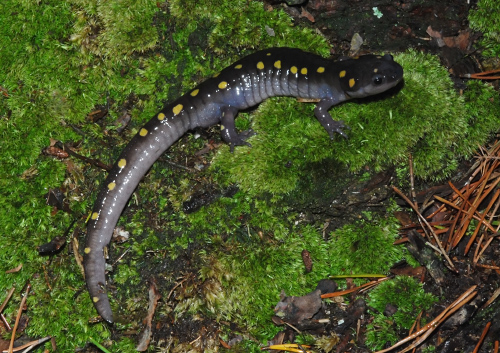The purpose of this feature is to give scout leaders, educators and naturalists an idea of some of the natural events coming up each month. We will try to cover a variety of natural events ranging from sky events to calling periods of amphibians, bird and mammal watching tips, prominent wildflowers and anything else that comes to mind. We will also note prominent constellations appearing over the eastern horizon at mid-evening each month for our area for those who would like to learn the constellations. If you have suggestions for other types of natural information you would like to see added to this calendar, let us know! Note: You can click on the hyperlinks to learn more about some of the featured items. To return to the Calendar, hit the "back" button on your browser, NOT the "back" button on the web page. All charts are available in a "printer friendly" mode, with black stars on a white background. Left clicking on each chart will take you to a printable black and white image. Please note that images on these pages are meant to be displayed at 100%. If your browser zooms into a higher magnification than that, the images may lose quality. Though we link book references to nationwide sources, we encourage you to support your local book store whenever possible. Notes and Images From December 2011
When I was in high school I ground and polished the mirror for a six inch reflecting telescope. After working through the winter and completing the telescope in the spring, my first magical look through the scope was at Jupiter. That was a few Jovian years ago, and after rebuilding our twenty inch reflector recently, we again saw first light observing Jupiter. Clouds passing overhead made the planet wink out every now and then. Although conditions were marginal and we were imaging at only half the image scale we'll eventually use, we managed to get the above portrait. Jupiter is a study in subtlety - nature painting with pastels. The visible outer atmosphere is constantly changing in appearance; clouds form and then are shredded by winds sometimes exceeding 200 miles per hour. The planet rotates in less than 10 hours, causing the equator to bulge noticeably. One immense storm, the Great Red Spot, has been seen in one form or another since the 17th century. Earth could easily fit inside this cyclone. In fact, Jupiter accounts for over two-thirds of the combined mass of all of the planets. A time lapse view of the rotation of the Great Red Spot made by the Cassini spacecraft can be seen here: The word jovial literally means to have the qualities of Jupiter (Jove), whose influence in medieval astrology was associated with a merry disposition. That seems about right for the season, and we finished the evening tired but elated.
Sky Events for January 2012: The Quadrantid Meteor Shower peaks in the early morning hours of January 4th. Look to the northeast below the handle of the Big Dipper. Evening Sky: Look for bright Jupiter at the beginning of the month along the Aries-Pisces border. The great planet is about 64 degrees above the southern horizon as the evening begins. Binoculars will show the Galilean moons if you hold them steady. Venus shines brilliantly in the southwest after sunset. At magnitude -4.0, it is the brightest starlike object in the sky. Mars rises about 10:09pm near Leo the Lion's rear foot at the beginning of the month. The red planet is steadily brightening, and will be at magnitude -0.5 by the end of the month. Though still small telescopically, it grows from 9 seconds of an arc to 11.7 seconds of an arc in January. Morning Sky: Saturn rises about 1:13am at the beginning of the month, and will be in good position to view in the predawn sky before sunrise. It rises near and a little below the bright star Spica in Virgo. Saturn will be the brighter of the two objects. The rings are now open to 15 degrees of tilt. Just about any telescope will give a stunning view. Mercury, having reached greatest elongation on December 23rd, is now sinking back towards the eastern horizon. On January 1st look for it about 9 degrees above the southeastern horizon thirty minutes before sunrise. All times noted in the Sky Events are for Franklin, Tennessee and are Central Standard Time. These times should be pretty close anywhere in the mid-state area. Constellations: The views below show the sky looking east at 9:30pm CST on January 15th. The first view shows the sky with the constellation outlines and names depicted. Star and planet names are in green. Constellation names are in blue. The second view shows the same scene without labels. Ursa Major, the Great Bear, has now cleared the horizon in the northeast. The bright stars of Leo, the Lion, are visible now and Hydra, the Water Serpent, rears its head menacingly. Hydra's brightest star Alphard is known as "The Solitary One" because of its somewhat isolated location from other bright stars. Canes Venatici, the Hunting Dogs, also makes its appearance just above the northeast horizon. Among the fainter constellations visible in the east are Leo Minor, the Small Lion, Cancer, the Crab, and Sextans, the Sextant. Mars is just below the eastern horizon, hidden in the treetops.
Due south are the brilliant stars of Orion and Canis Major. The Orion Nebula, M42, is one of the most magnificent emission nebulas in the sky. The pink glow of hydrogen alpha light is visible only in very large telescopes and the nebula appears as a small greenish glow in small telescopes. Near Alnitak, the lowest star in Orion's belt when the constellation is due south, are two fainter nebula; the Flame Nebula and the dark Horsehead Nebula. Crouching beneath the feet of Orion, is Lepus, the Hare. Sirius, the brightest star in the sky, shines below Orion.
On Learning the Constellations: We advise learning a few constellations each month, and then following them through the seasons. Once you associate a particular constellation coming over the eastern horizon at a certain time of year, you may start thinking about it like an old friend, looking forward to its arrival each season. The stars in the evening scene above, for instance, will always be in the same place relative to the horizon at the same time and date each January. In particular, learn the brightest stars (like Regulus and Procyon in the scene looking east), for they will guide you to the fainter stars. Once you can locate the more prominent constellations, you can "branch out" to other constellations around them. It may take you a little while to get a sense of scale, to translate what you see on the computer screen or what you see on the page of a book to what you see in the sky. Look for patterns, like the stars of Leo. The earth's rotation causes the constellations to appear to move across the sky just as the sun and the moon appear to do. If you go outside earlier than the time shown on the charts, the constellations will be lower to the eastern horizon. If you observe later, they will have climbed higher. As each season progresses, the earth's motion around the sun causes the constellations to appear a little farther towards the west each night for any given time of night. If you want to see where the constellations in the above figures will be on February 15th at 9:30pm CST, you can stay up till 11:30pm CST on the January 15th and get a preview. The westward motion of the constellations is equivalent to two hours per month. For instance, if you want to see what stars will be on your eastern horizon on April 15th at 9:30pm CST (3 months later), you would need to get up at 3:30am CST in the morning on January 15th (3 months times 2 hours/month = 6 hours). Recommended: Sky & Telescope's Pocket Star Atlas is beautiful, compact star atlas. It is destined to become a classic, and is a joy to use at the telescope. A good book to learn the constellations is Patterns in the Sky, by Hewitt-White. You may also want to check out at H. A. Rey's classic, The Stars, A New Way to See Them. For skywatching tips, an inexpensive good guide is Secrets of Stargazing, by Becky Ramotowski. A good general reference book on astronomy is the Peterson
Field Guide,
A Field Guide to the Stars and Planets, by Pasachoff. The book retails for around $14.00. Starry Night has several software programs for learning the night sky. Visit the Starry Night web site at www.starrynight.com for details.
Amphibians:
A lot of things happen with amphibians in January. To see them, though, you have to be out in the sort of weather that makes most people stay indoors. The trick is to go out on mild (50 degrees Fahrenheit or warmer) rainy nights. For safety, it is important that you have another person with you to watch for traffic as you slowly drive the back roads, looking for things that cross the road in front of you. Make frequent stops to listen for calling frogs. In January, both Spring Peepers and Upland Chorus Frogs are not uncommon, and Wood Frogs have their short-lived breeding choruses in woodland ponds. Southern Leopard Frogs are also sometimes calling on mild January nights. We have seen Northern Cricket Frogs, Green Frogs, American Bullfrogs and American Toads foraging in January. And just about anything is possible. On January 22, 1999, we found a Eastern Spadefoot out in the stormy weather. That same day a tornado ripped through Clarksville, Tennessee, doing much damage to the Austin Peay campus. January is an exciting time of year to look for herps! Recommended: The Frogs and Toads of North America, Lang Elliott, Houghton Mifflin Co.
Winter Pond Life: Although some Tennessee wildlife is in a dormant state during the winter months, many species remain active. Small ponds are a good habitat to check for some of these species. Frogs and toads forage around the edges of ponds on mild winter evenings, and you can see them by placing a flashlight or spotlight beside your temple and slowly scanning the banks. It is important to have the beam of light close to your eyes, as this maximizes the amount of reflected eye-shine that you see. You can also do your scan with a spotlight and binoculars. We have found many frogs and toads in the winter this way. Being familiar with the calls of frogs that breed during the winter is also helpful. Upland Chorus Frogs, Spring Peepers and Wood Frogs all call in January.
Tiger Salamanders and Spotted Salamanders breed during the early winter, and you can sometimes find their egg masses in ponds. Rainy nights are the best time to check for adult salamanders, but you can check for the egg masses anytime. Red-spotted Newts can also be seen with a spotlight in the shallow water near the pond's edge.
Some of the most interesting wildlife to be found in winter ponds occurs on a small scale. Many insects and crustaceans can be found in the water or beneath the ice, and collecting a few water samples and examining them with a hand lens or small microscope will give you a window into their world. Freshwater crustaceans like the Daphnia, Cyclops and Seed Shrimp are common in ponds and pools, as are many types of small snails. Dragonfly larvae will spend the winter as larvae before transforming to their summer adult form. The word larva comes from the Latin word for ghost or specter. Both larval and the adult dragonflies are voracious predators. The larval dragonflies are in turn preyed upon by frogs and newts. With the exception of the dragonfly larva, all of the creatures shown at right are less than three millimeters in length. All came from one small sample of water we took by breaking through the ice covering a small pond near Springfield, Tennessee. After photographing them, we released them back into the pond.
Archives (Remember to use the back button on your browser, NOT the back button on the web page!) Natural Calendar December 2011 Natural Calendar November 2011 Natural Calendar September 2011 Natural Calendar February 2011 Natural Calendar December 2010 Natural Calendar November 2010 Natural Calendar September 2010 Natural Calendar February 2010 Natural Calendar December 2009 Natural Calendar November 2009 Natural Calendar September 2009 Natural Calendar February 2009 Natural Calendar December 2008 Natural Calendar November 2008 Natural Calendar September 2008 Natural Calendar February 2008 Natural Calendar December 2007 Natural Calendar November 2007 Natural Calendar September 2007 Natural Calendar February 2007 Natural Calendar December 2006 Natural Calendar November 2006 Natural Calendar September 2006 Natural Calendar February 2006
Natural Calendar
December 2005
Natural Calendar
November 2005
Natural Calendar
September 2005
Natural Calendar
February 2005
Natural Calendar
December 2004
Natural Calendar
November 2004
Natural Calendar
September 2004
Natural Calendar
February 2004
Natural Calendar
December 2003
Natural Calendar
November 2003
Natural Calendar
September 2003 Natural Calendar February 2003 Natural Calendar December 2002 Natural Calendar November 2002 Nature Notes Archives: Nature Notes was a page we published in 2001 and 2002 containing our observations about everything from the northern lights display of November 2001 to frog and salamander egg masses. Night scenes prepared with The Sky Professional from Software Bisque All images and recordings © 2012 Leaps |
|||||||||||||
